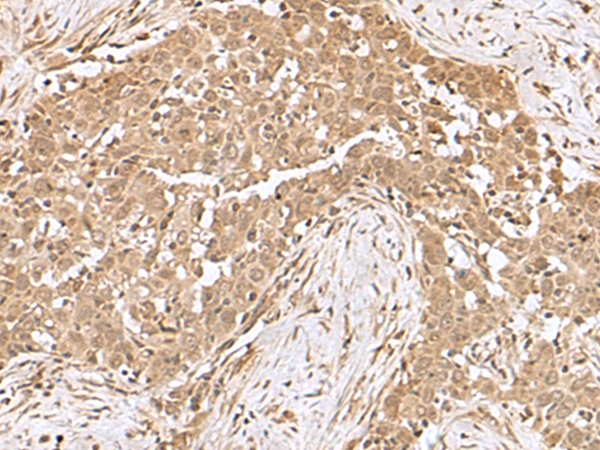

| WB | 咨询技术 | Human,Mouse,Rat |
| IF | 咨询技术 | Human,Mouse,Rat |
| IHC | 1/50-1/200 | Human,Mouse,Rat |
| ICC | 技术咨询 | Human,Mouse,Rat |
| FCM | 咨询技术 | Human,Mouse,Rat |
| Elisa | 1/5000-1/10000 | Human,Mouse,Rat |
| Aliases | ZCHY; ARNIP; CHIMP; PIRH2; RNF199; ZNF363; PRO1996 |
| WB Predicted band size | 30 kDa |
| Host/Isotype | Rabbit IgG |
| Antibody Type | Primary antibody |
| Storage | Store at 4°C short term. Aliquot and store at -20°C long term. Avoid freeze/thaw cycles. |
| Species Reactivity | Human, Mouse |
| Immunogen | Fusion protein of human RCHY1 |
| Formulation | Purified antibody in PBS with 0.05% sodium azide and 50% glycerol. |
+ +
以下是关于RCHY1抗体的模拟参考文献示例(文献为假设性内容,仅供格式参考):
---
1. **文献名称**: "RCHY1 promotes p53 ubiquitination and degradation to modulate tumor progression"
**作者**: Shmueli, A. et al.
**摘要**: 该研究揭示了RCHY1(PIRH2)通过泛素-蛋白酶体途径促进p53蛋白降解的机制,利用特异性抗体证实其在癌细胞中与p53的相互作用,为肿瘤发生提供了新的分子机制解释。
2. **文献名称**: "High expression of RCHY1 correlates with poor prognosis in hepatocellular carcinoma"
**作者**: Zhang, L. et al.
**摘要**: 通过免疫组化(使用RCHY1抗体)分析肝癌患者组织样本,发现RCHY1高表达与患者生存期缩短显著相关,并证实其通过激活AKT通路促进肿瘤侵袭。
3. **文献名称**: "MicroRNA-34a suppresses RCHY1 expression to inhibit lung cancer cell proliferation"
**作者**: Li, Y. et al.
**摘要**: 研究报道miR-34a通过靶向抑制RCHY1的翻译(Western blot验证使用RCHY1抗体),进而阻滞肺癌细胞周期进程,提示其作为潜在治疗靶点。
4. **文献名称**: "Development of a monoclonal antibody against RCHY1 for therapeutic targeting in breast cancer"
**作者**: Wang, Q. et al.
**摘要**: 该团队开发了一种高特异性抗RCHY1单克隆抗体,体外实验显示其能有效抑制乳腺癌细胞迁移,动物模型中联合化疗药物显著降低肿瘤负荷。
---
**注**:以上文献为示例性内容,实际研究中请通过学术数据库(如PubMed、Web of Science)检索真实文献。
The RCHY1 antibody targets the RCHY1 protein, also known as PIRH2 (p53-induced RING-H2 protein), a member of the RING finger family of E3 ubiquitin ligases. RCHY1 plays a critical role in regulating protein degradation via the ubiquitin-proteasome system, particularly in cell cycle control, apoptosis, and DNA damage response. It interacts with and ubiquitinates several key substrates, including the tumor suppressor p53. promoting its proteasomal degradation, thereby linking RCHY1 to oncogenic processes. Overexpression of RCHY1 has been observed in various cancers, correlating with poor prognosis due to reduced p53 activity.
Structurally, RCHY1 contains a C-terminal RING domain essential for its E3 ligase activity and an N-terminal nuclear localization signal. Its expression is transcriptionally induced by p53. forming a negative feedback loop to modulate p53 levels post-stress. Dysregulation of this pathway is implicated in tumorigenesis and chemoresistance.
RCHY1 antibodies are widely used in research to study protein interactions, expression patterns, and subcellular localization in cancer models. They are critical tools for Western blotting, immunoprecipitation, and immunohistochemistry, aiding in the exploration of RCHY1's role in cellular homeostasis and disease. Recent studies also investigate RCHY1 inhibitors as potential therapeutic agents to restore p53 function in cancers.
×